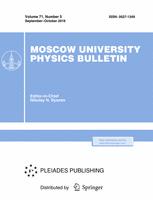The spectral and optical properties of the fractionated components of dissolved organic matter (DOM) of three freshwater lakes in Karelia were studied using reversed-phase high-performance liquid chromatography (RP-HPLC) with online detection of fluorescence and absorption spectra. It is shown that the DOM fractions are qualitatively similar, but differ quantitatively in the ratio of components and consist of at least three types of fluorophores: (1) hydrophilic “humic-like” fluorophore(s) with the emission maximum in the region of 420 nm and an absorption band at 260–270 nm; (2) hydrophobic “humic-like” fluorophore(s) with the emission maximum at approximately 450 nm that has no characteristic absorption maxima in the region from 220 to 400 nm; and (3) a “protein-like” fluorophore with the emission maximum in the region of 340–350 nm, which is typical of proteins and peptides containing tryptophan
82.80.Bg Chromatography
$^1$Department of General Physics, Faculty of physics, Lomonosov Moscow State University\
$^2$Institute of Basic Biological Problems RAS\
$^3$Branch of Shemyakin and Ovchinnikov Institute of Bioorganic Chemistry, Russian Academy of Sciences



